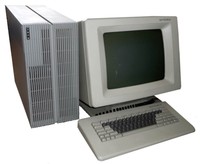Symbolics 3620
| Home > Browse Our Collection > Computers > Symbolics > Symbolics 3620 |
|
In 1983, a year later than planned, Symbolics introduced the 3600 family of Lisp machines. Code-named the "L-machine" internally, the 3600 family was an innovative new design, inspired by the CADR architecture but sharing few of its implementation details. The main processor had a 36 bit word (divided up as 4 or 8 bits of tags, and 32 bits of data or 28 bits of memory address). Memory words were 44 bits, the additional 8 bits being used for error-correcting code (ECC). The instruction set was that of a stack machine. The 3600 architecture provided 4,096 hardware registers, of which half were used as a cache for the top of the control stack; the rest were used by the microcode and time-critical routines of the operating system and Lisp run-time environment. Hardware support was provided for virtual memory, which was common for machines in its class, and for garbage collection, which was unique. The original 3600 processor was a micro-programmed design like the CADR, and was built on several large circuit boards from standard TTL integrated circuits, both features being common for commercial computers in its class at the time. CPU clock speed varied depending on the particular instruction being executed, but was typically around 5 MHz. Many Lisp primitives could be executed in a single clock cycle. Disk I/O was handled by multitasking at the microcode level. A 68000 processor (known as the "Front-End Processor", or FEP) started the main computer up, and handled the slower peripherals during normal operation. An Ethernet interface was standard equipment, replacing the Chaosnet interface of the LM-2. The 3600 was roughly the size of a household refrigerator. This was partly due to the size of the processor — the cards were widely spaced to allow wire-wrap prototype cards to fit without interference — and partly due to the limitations of the disk drive technology in the early 1980s. At the 3600's introduction, the smallest disk drive that could support the ZetaLisp software was 14 inches (356 mm) across (most 3600s shipped with the Fujitsu Eagle). The 3670 and 3675 were slightly shorter in height, but were essentially the same machine packed a little tighter. The advent of 8 inches (200 mm), and later 51/4 inches (130 mm), disk drives that could hold hundreds of megabytes led to the introduction of the 3640 and 3645, which were roughly the size of a two-drawer file cabinet. Later versions of the 3600 architecture were implemented on custom integrated circuits, reducing the 5 cards of the original processor design to 2, at a large manufacturing cost savings but with performance slightly better than the old design. The 3650, first of the "G machines" (as they were known within the company), was housed in a cabinet derived from the 3640s. Denser memory and smaller disk drives enabled the introduction of the 3620, about the size of a modern full-size tower PC. The 3630 was a "fat 3620" with room for more memory and video interface cards. The 3610 was a lower priced variant of the 3620, essentially identical in every way except that it was licensed for application deployment rather than general development. Symbolics developed the first workstations capable of processing HDTV quality video, which enjoyed a popular following in Japan. A 3600 — with the standard black-and-white monitor — made a cameo appearance in the movie Real Genius. The company was also referenced in Michael Crichton's novel Jurassic Park. The Symbolics 3620 is designed to address users' demands for increasingly powerful software development capabilities in smaller and more economical hardware packages. The new system is designed for entry-level development and expandable delivery of symbolic processing applications. Well suited to any work environment, the 3620 can be configured for rack mounting or as a floor-standing pedestal. The minimum configuration includes a processor, monochrome console with keyboard and mouse, 190-mb fixed disk, four megabytes of main memory, Ethernet interface and backplane. Price is $49,900. Options include up to 16MB memory, additional 190 MB fixed disk or cartridge tape, floating-point accelerator and printer support. Our machine is model number 3620 with a part number of 365604-1 and a serial number of 20287. It is complete with the original monitor and keyboard - model number 2500, part number 364000. Kindly donated by Neil Hubbard. Manufacturer: Symbolics Comment on This Page Symbolics 3620 Manuals:
This exhibit has a reference ID of CH22982. Please quote this reference ID in any communication with the Centre for Computing History. |
|













